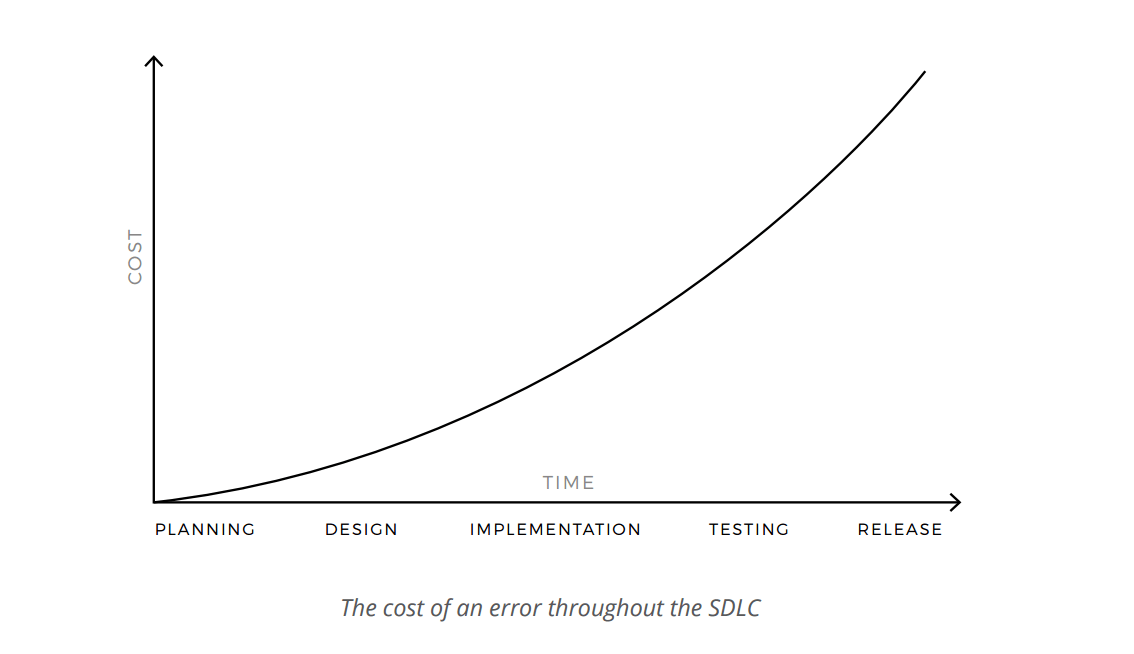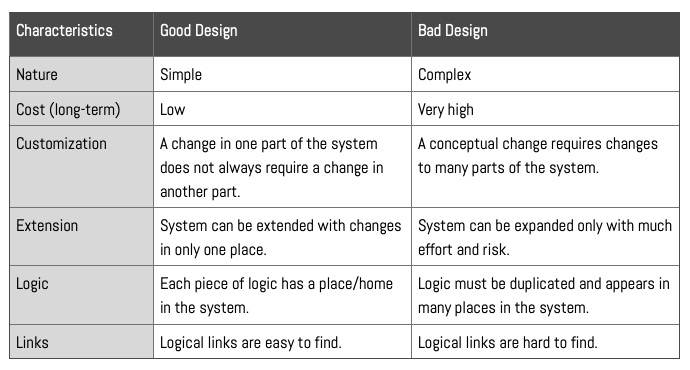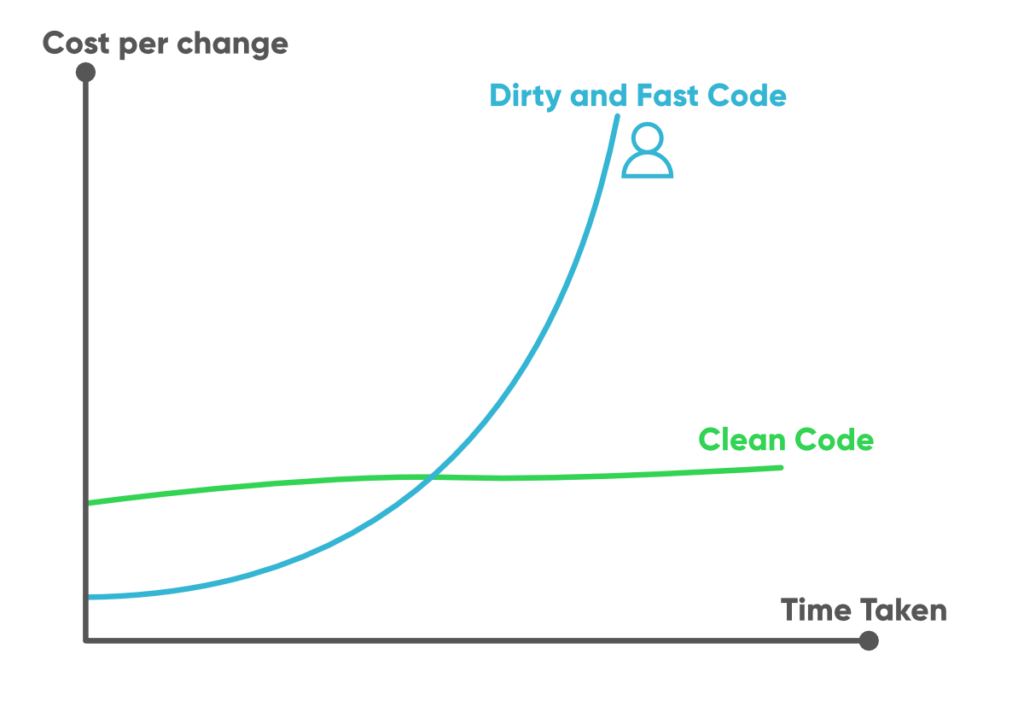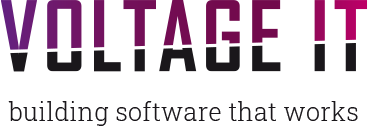“Quick & dirty” software development saves time short-term, but can do more harm than good in the long run This calls for rethinking software development and returning to quality craftsmanship. Learn here what it takes to achieve this.
Software that is developed quickly but poorly causes immense damage worldwide – most of it through software failures in operation. According to studies, the cost of failures due to poor software quality in the US was $1.56 trillion in 2020. This is 10 times more expensive than preventing or fixing errors in development before the software goes live.
As software evolves and grows, its architecture tends to become more complex. This makes maintaining the software difficult and error-prone. Moreover, if design, architecture and source code are poorly crafted from the beginning, sooner or later every adjustment, no matter how small it is, can become a nightmare for product owners and developers.
The challenge for developers is to avoid errors in the programming code or to detect bugs as early as possible so that they can be fixed at relatively low cost. To achieve this, software craftsmanship and quality management must interact closely from the very first line of code. The basis for high-quality and sustainable software is already laid in code line 1.
Reasonable software development aims to balance speed and quality in the best possible way. The key is in good software design, created sustainably rather than “quick & dirty”.
Basic Values of our Software Craftsmanship
- Quality: Software should not only work, but also be well crafted
- Added value: We do not only react to changes, but constantly add value
- Team: Not individuals create great results, but a community of professionals
- Cooperation: Productive partnerships instead of just cooperation with customers
Source: manifesto.softwarecraftsmanship.org
Deliver complex software quickly and at top quality
Thanks to advanced tools and methods, software code is nowadays published faster than ever before. This allows companies to develop new features in less time. At the same time, the complexity of functions is growing, which used to take much more time for development and testing than it does today. However, this positive trend reaches its limits when software quality suffers from time pressure and complex requirements.

The challenge: The faster companies develop new functions, the more difficult it is to ensure software quality and reliability. Very short testing cycles increase the risk that more errors will go undetected and find their way into production. Depending on the frequency and scope of software customizations, these errors accumulate and sooner or later let software design and architecture erode. The cost of finding and fixing bugs in a rotten system increases with each customization.
The cost of an error in the software development process
Finding and fixing critical software bugs during operation is 10 times more expensive than finding and fixing them before the software is put into operation. It is therefore worth investing in the prevention of errors through clean code and good software design at the beginning, instead of developing “quick & dirty” under time pressure.

Source: altexsoft.com
The downside of “quick & dirty” development
Software erosion, decay or rot refers to the creeping deterioration of software as a result of poor planning and/or implementation. Indications for software erosion are e.g. the accumulation of program errors, more difficult adaptability, decreasing performance, as well as incompatibilities with new features and future software environments. In the medium term the software gets a “code smell”, whereby the source code still works, but is poorly structured. The software gradually becomes a legacy system and thus ends functionally and economically unusable.
Symptoms of rotten software design
- Rigidity: the system is difficult and costly to change
- Fragility: small changes have unpredictable consequences for the system
- Inflexibility: individual components are difficult to isolate
- Viscosity: software architecture is difficult to maintain when changed
- Unnecessary complexity: the software contains infrastructure with no tangible benefit
- Unnecessary repetition: architecture contains repetitive code structures
- Opacity: source code is difficult to read and understand
Source: based on Robert C. Martin
Sustainable software development instead of “quick & dirty”
High-quality software depends on high-quality design and code. The path for quality is set in the design, because the plan for a computer software is as important as the plan for a house – poorly designed implementation ends in chaos. The software design defines what is to be built in the form of software code. That’s why both – design and code – require the highest level of craftsmanship.
The role of good software design
Good design costs time and effort today, but pays off by making it easier to develop the software in the future. Poor design saves time and effort in the short term, but creates technical debt that slows software development productivity in the long run.

Source: martinfowler.com
Good versus bad software design

Source: based on geeksforgeeks.org
The role of good software code
The quality and structure of the source code are crucial for crafting software sustainably. If software code is developed quickly and “dirty” due to time pressure and cost restrictions from the beginning, errors will occur causing costs later in the project. Unlike “clean code”, written in a simple and structured way, the costs for adapting “dirty” code grow over time.

Source: geeksforgeeks.org
Only the developer who wrote the “dirty and fast code” is able to cope with it, but after some time and thousands of lines every developer will struggle to understand his own code. And what happens if he/ she is absent, for example due to illness, vacation or because he moves to another company? Then disaster can strike – the so-called “bus factor” illustrates this.
Side note: The “bus factor” quantifies the minimum number of developers in a team who must suddenly disappear from a project so that a project grinds to a halt due to lack of code knowledge. If only one developer knows the code, the risk is extremely high that a project ends up in chaos if this developer drops out. Therefore, we recommend to always share code knowledge within the team. If developers have to work on third-party code, the effort increases immensely, since they need to understand the individual structure before they can adapt it. And even if they do, it is still hard to assess the risks of changes, since hidden links in the system are not easy to identify. “Clean code”, on the other hand, makes it much easier for developers who haven’t written the code themselves to understand structures and make changes with minimal risk.
“Clean code is simple and direct. Clean code reads like well-written prose. Clean code never obscures the designer’s intent but rather is full of crisp abstractions and straightforward lines of control.” –Grady Booch (Aauthor of Object Oriented Analysis and Design with Applications)
Recommended reading on the importance of architecture for software sustainability:
Software Architecture for SMB: Microservices vs Monolith – What’s the best solution?
Agile software development according to craft principles
Developing software quick & dirty causes immense technical debts and makes product owners in companies suffer. That is why we at voltage IT follow the principles of “Software Craftsmanship” in solution development, which consistently prioritizes sustainable quality over short-term success.
Sustainable software design and clean code play a central role in our projects. For the implementation we use agile methods and tools:
- TDD (Test Driven Development): The functionality of each software feature is monitored via at least one automated test. This ensures security and confidence in code changes and enables fast development cycles without manual test runs.
- Pair Programming/ Continuous Code Review: While one developer writes the code, another provides ongoing feedback and makes suggestions for improvement. This results in higher quality code while the developer continues working and saves subsequent code reviews.
- Refactoring: Well-made software must be deeply and continuously refactored to remain well-made. With refactoring, the internal structure of existing code is adapted without changing the system’s behavior.
- Continuous Delivery: Code is adapted in very short cycles so that changes remain verifiable for the entire team at all times. This enables avoiding large, hidden software errors in production and to fix smaller defects at lightning speed.
Final words in conclusion: In many areas of our lives, manual tasks could be rationalized by assembly lines and automation, which in many cases has its justification from an economic point of view. Over many years and in many projects we have learned that assembly line work in software development is limited and does more harm than good. Good software still needs good craftsmanship, and that will remain the case.
Worth reading
- Refactoring – Short introduction by Martin Fowler (refactoring.com)
- DesignStaminaHypothesis – Is it worth the effort to design software well? (martinfowler.com)
- Cost of Poor Software Quality in the US: 2020 Report (it-cisq.org)
Need help? Let’s talk!
For many years we aim to enable companies to make the right IT decisions and to get software systems they sustainably benefit from and manage themselves in the long term. Our mission: Building “reasonable” solutions beyond technology hype.
